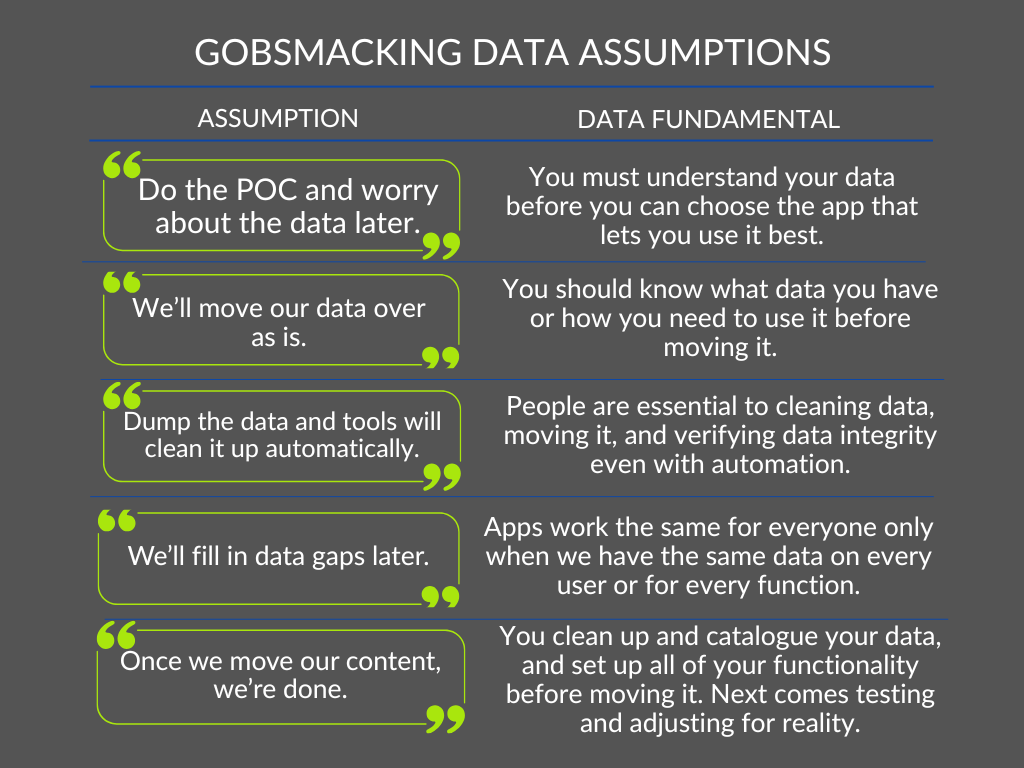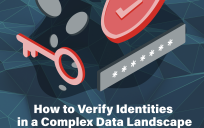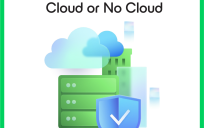Talk about data is so ubiquitous that it has become background noise for many of us.
But in our organizations, we have to understand enough about data that we can use it to make sound business decisions.

Despite, or perhaps because of, the abundance of PowerPoints, Excel workbooks, charts, and Jira tickets that populate our working lives, the business side of data tends to be about interactions, customers, site visitors, and efficiencies.
That data is only part of what drives business processes — and even then, it’s the nitty gritty about such data and how it relates to other data that lets us accomplish anything.
Good data drives productivity and functionality, and leaders have to understand how problems with data hinder growth. The following are quotes from my clients that illustrate some of these issues.

1. Do the Proof-of-Concept and Worry About the Data Later
This client was in a rush to implement after years of delays. Since almost all projects are behind schedule, this comes up a lot.
From the tech side, we see the same sentiment expressed as, “I’ll build the system, then worry about the data.”
The fundamental issue here is that all software runs on data, like all vehicles run on fuel. You have to know what fuel is available to know what kind of vehicle to buy. You wouldn’t buy an electric vehicle (EV) if your area has no EV charging stations.
It’s the same with data — you make applications to use your data, so you have to understand your data before you build, modify, or buy an application. Most organizations buy applications, then try to force their data to fit it. It seldom works well.
2. We’ll Move Our Data Over as Is
This seems like a reasonable stance, but you can’t move data that you don’t know you have.
To know if your data is missing, bad, or incomplete, you need to inventory it and ask questions, including:
- Who owns the data?
- What kind of data do we have?
- Where does it live? In databases, Excel sheets? Google docs? Inside of proprietary software? All of the above?
- When is it updated?
- Why do we have it or what function does it drive?
- How does it talk to other software apps?
- How do we ask questions of it? And when we do, can we understand the data?
This process should be ongoing but certainly needs to happen before you begin shopping or building apps in earnest because you should buy applications to handle your data, not create data to fit someone else’s application.
3. Dump the Data and Tools Will Clean it up Automatically
Automation is the right approach, because it not only speeds up our ability to use data, it takes away much of the potential for human error. But when you read “automatically”, the subtext is “we can launch the process and our IT folks can do other things while it runs in the background.”
It’s important to understand that automating data processing means people will have an essential role in cleaning up the data, moving it through the cleanup pipeline, and verifying the results.
Apps can help us move and clean data, but we first have to tell them what to look for. That’s because organizations always store data that comes from multiple sources in many places. For example, without people, machines will not know that one source calls a field “last name” and another uses “surname”.
4. We’ll Gather Data Moving Forward and Fill in Gaps From the Past Later
To make your applications work equally well for everyone, we need the same data on every user or for every function. To understand what data is missing, you’ll need to know what data you have. And if you’ve gathered different data at different points in time, you’ll have to find the gaps in data to fill them. This is almost impossible if you have no idea where the gaps are. We don’t know what we don’t know.
If you know what data you have and the function it needs to drive (see No. 1 above) then you’ll need that data to be as complete as possible to make your apps work, to make them work the same across users, and to ask questions of your data and get sensible answers.
5. Once We Move our Content, We’re Done
If you cleaned up your data, cataloged it, and set up all of your functionality before moving your content, after the content transfer, you’re halfway to being done.
I don’t say halfway to be discouraging, because if you’ve done all of that data prep, you’re waaaaayyyy ahead of the game. You’ll be able to move data and start testing to see if it works as you need it to. If it doesn’t, you’ll be able to look at how the data supports your app and change or add data as needed.
Prepping your data sets you up for success.
Data Literacy Must Come From the Top
Understanding the importance of data is paramount to meeting organizational goals. In my experience, leaders have to understand the process enough to support it, both in time and budget. It’s best to have clean data as you go, but undertaking new projects is a great time to assess and inventory your data.
Evelyn L. Kent is the owner of Bacon Tree Consulting, a firm that helps clients with digital transformation; systems analysis; validating AI and machine learning models; data forensics; metadata management; text analytics; and building semantic models, ontologies, and knowledge graphs. Evelyn helps organizations find and solve the data barriers that block enterprises from innovation, new markets, and efficient operations. She regularly writes and presents on all things data.





Leave a Reply
You must be logged in to post a comment.